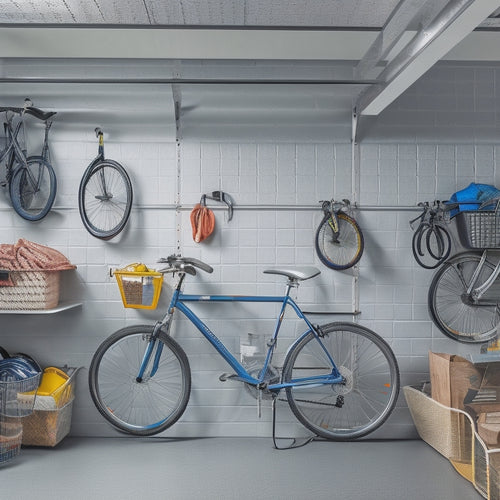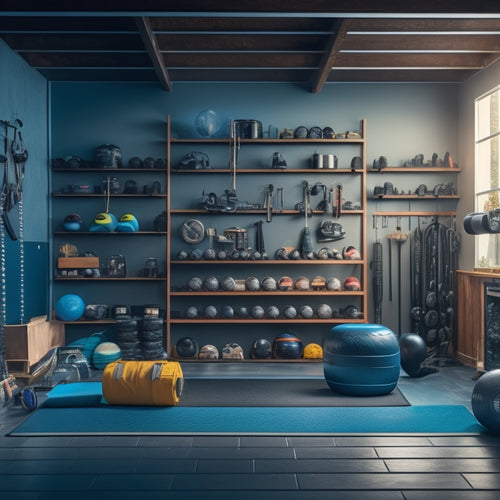
Streamline Your Garage: Boost Functionality With Ease
Share
You're tired of wasting time and energy in a cluttered garage. It's time to streamline this space and boost functionality with ease. Start by evaluating your garage's layout, identifying areas that need attention, and determining its primary purpose. Purge unwanted items, categorize what's left, and assign tasks to specific zones. Utilize vertical storage options, install shelving and cabinets, and implement clear labeling systems. By following these steps, you'll reclaim floor space, optimize efficiency, and maximize productivity. Now, take the next step to transform your garage into a haven of functionality and discover the secrets to maintaining your new space.
Key Takeaways
• Assess your garage's layout, purpose, and storage to identify areas for improvement and optimize functionality.
• Purge unwanted items, sort remaining ones into categories, and assign a designated place for each to maintain organization.
• Divide the garage into task-specific zones, utilizing vertical storage options and shelving to maximize space and efficiency.
• Implement a clear labeling system with color coding and zone identification signs to enhance organization and ease of use.
• Schedule regular tune-ups and reassess storage solutions to maintain an organized garage that adapts to changing needs.
Assessing Current Garage Conditions
What's the current state of your garage - is it a cluttered chaos or a relatively organized space? Take a step back and assess the layout of your garage. Are there clear pathways for moving around, or are you constantly tripping over tools and storage bins? Identify the areas that need the most attention and prioritize them.
Consider the purpose of your garage - is it solely for parking, or do you use it as a workshop or storage space? This will help you determine the most effective garage layout for your needs.
Next, take stock of your storage solutions. Are you using shelving units, cabinets, or bins to keep items off the floor? Are they organized in a way that makes sense, or are they cluttered and disorganized? Make a mental note of what's working and what's not.
This assessment will help you identify areas for improvement and inform your decisions as you move forward with streamlining your garage. By understanding your garage's current state, you'll be better equipped to create a functional and efficient space that meets your needs.
Purge and Declutter Garage Space
Now that you've assessed your garage's current condition, it's time to tackle the clutter.
You'll need to sort items into categories, deciding what to keep, donate, sell, or discard.
Sort and Categorize Items
Take everything out of your garage and sort items into categories, such as tools, sports equipment, and seasonal decorations, to visualize the scope of your belongings and identify what can be eliminated or donated. This step is pivotal in item categorization, as it allows you to see what you have and where it can be stored.
Next, use sorting methods like grouping similar items together or categorizing by frequency of use to further refine your organization techniques.
As you sort, consider the storage solutions you'll need for each category. For example, you may need bins for seasonal decorations or a pegboard for tools. Having a clear plan for storage will help you make the most of your garage's space and guarantee that everything has a designated home.
Remember to be systematic and precise in your approach, as this will make it easier to maintain your newly organized garage in the long run. By taking the time to sort and categorize your items, you'll be well on your way to a more functional and clutter-free garage.
Discard Unwanted Clutter
As you've sorted and categorized your garage items, you're likely left with a substantial amount of clutter that's simply taking up valuable space. It's time to adopt a minimalist approach and purge unwanted items. Go through each category and be ruthless – if you haven't used it in the past year, it's probably safe to get rid of it. Consider donating gently used items to local charities or selling them through online marketplaces. This won't only declutter your garage but also make some extra cash.
For items that can't be donated or sold, explore recycling solutions. Many communities have programs for recycling electronics, batteries, and other hazardous materials. Take advantage of these services to responsibly dispose of unwanted items.
Organizational tips include setting up a 'donate' and 'recycle' box in your garage to collect items as you sort. This will make it easy to drop off items at a later time. By discarding unwanted clutter, you'll be left with a more functional and organized garage space that makes your life easier.
Categorize and Group Similar Items
Categorizing similar items into distinct groups enables you to quickly identify what you have, making it easier to find what you need when you need it. This is where item organization and grouping efficiency come into play. By categorizing items, you'll be able to see what you have, what you need, and what you can get rid of.
When categorizing, consider the type of item, its frequency of use, and its size. For example, group all your tools together, and then sub-divide them into categories like hand tools, power tools, and gardening tools. This will make it easy to find the specific tool you need.
Some categorization tips to keep in mind include storing items that are used together in the same area, and labeling each category so you can easily identify what's inside. Additionally, consider your storage solutions, such as bins, baskets, and shelves, to keep items off the floor and out of the way.
Assigning Tasks to Zones
Divide your garage into zones, each dedicated to a specific task or activity, such as a workstation for projects, a maintenance area for vehicle upkeep, or a storage zone for seasonal decorations. By doing so, you'll create a zone organization that optimizes efficiency and space utilization. This task delegation approach allows you to focus on one task at a time, reducing clutter and increasing productivity.
Assign tasks to each zone based on your needs and preferences. For instance, designate a specific area for tool storage, another for sports equipment, and a separate zone for gardening supplies. This structured approach guarantees that everything has its designated place, making it easier to find what you need when you need it.
Utilizing Vertical Storage Options
By assigning tasks to zones, you've optimized your garage's floor space, but now it's time to make the most of your walls and ceiling by incorporating vertical storage options that will further maximize your garage's storage capacity. This is where space optimization comes into play. Vertical solutions are a game-changer when it comes to garage organization. They allow you to store items that are infrequently used, freeing up valuable floor space for more essential items.
Consider installing overhead storage racks for bikes, kayaks, or other bulky items. You can also use wall-mounted hooks, bins, and baskets to store items like tools, sports equipment, or seasonal decorations.
Another option is to install slatwall panels, which provide a versatile and customizable storage solution. By utilizing vertical storage options, you'll be able to reclaim your garage's floor space and create a more organized, clutter-free environment.
With a little creativity, you can turn your garage's walls and ceiling into valuable storage real estate, making the most of your space and streamlining your garage's functionality.
Installing Shelving and Cabinets
To further optimize your garage's storage capacity, you'll want to install shelving and cabinets that provide a dedicated space for your gear, tools, and supplies. This will enable you to maximize your garage's space optimization, ensuring an efficient layout that makes the most of every square foot.
When selecting shelving and cabinets, consider your specific needs and preferences. Look for stylish design options that complement your garage's aesthetic, and explore customization options to fit your unique requirements. For instance, you might opt for adjustable shelving to accommodate items of varying sizes or choose cabinets with locking mechanisms to secure valuable equipment.
Labeling and Signage Strategies
As you organize your garage, you'll want to create a system that helps you quickly find what you need. To achieve this, you'll need to implement clear labeling systems that identify what's stored in each cabinet, shelf, or bin.
Clear Labeling Systems
You can efficiently categorize and locate items in your garage by implementing a clear labeling system that incorporates specific labels and signs strategically placed throughout the space. This system helps you quickly identify where items are stored, saving you time and effort.
To create an effective labeling system, start by color coding your labels to differentiate between categories, such as tools, sports equipment, or seasonal decorations. This visual aid helps you instantly recognize the type of item stored in a particular area.
Next, use descriptive labels that clearly state what's stored in each bin, shelf, or cabinet. This eliminates the need to rummage through containers or open cabinets to find what you need.
Additionally, consider using visual aids like icons or images to supplement your labels, making it even easier to identify contents at a glance.
Zone Identification Signs
Your garage's organization is further enhanced by zone identification signs that clearly define specific areas, such as a 'Tool Zone' or 'Seasonal Storage Area', guiding you directly to the items you need. These signs create a visual zoning effect, allowing you to quickly identify where items are stored.
By using color coding, you can take it a step further and assign specific colors to each zone. For instance, you can use blue for tools and red for seasonal decorations. This visual cue helps you navigate your garage with ease, saving you time and frustration.
When creating your zone identification signs, make sure to keep the labels concise and clear. Avoid using complex descriptions or jargon that might confuse you or others using the garage. Instead, opt for simple and descriptive labels that immediately convey the contents of each zone.
Maintaining Your Organized Garage
Maintaining Your Organized Garage
Regular tune-ups and adjustments guarantee your newly organized garage remains a haven of efficiency and productivity. To secure your space stays clutter-free, set aside time each month to reassess your storage solutions and space optimization.
Go through each zone, checking if items are still in their assigned spots and if there's anything that needs to be adjusted. Make sure everything is easily accessible and that you're not wasting any space.
You'll also want to uphold the efficiency of your garage by regularly cleaning and dusting surfaces, as well as checking for any damage or wear on your storage systems. This will help prevent clutter from building up again and keep your garage looking its best.
Related Posts
-

7 Best Practices to Design a Garage Storage System
To design an effective garage storage system, start by evaluating your storage needs, measuring your garage space acc...
-

7 Best Garage Storage Solutions for Busy Families
You're tired of a cluttered garage, and it's time to reclaim your space. As a busy family, you need storage solutions...
-

Why Home Gyms in Garages Need Smart Storage
You've invested in a home gym in your garage, but without smart storage, your workouts are easily derailed by clutter...


